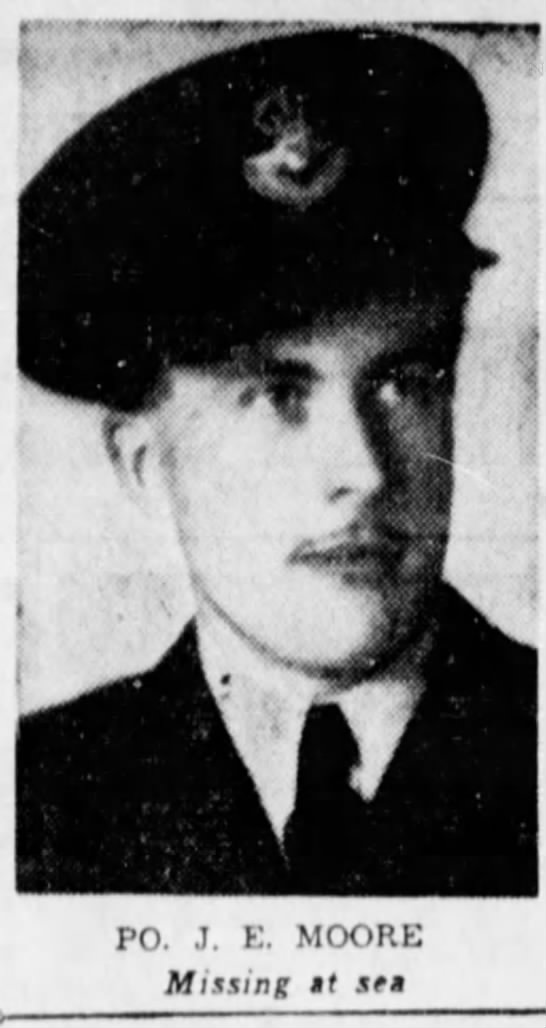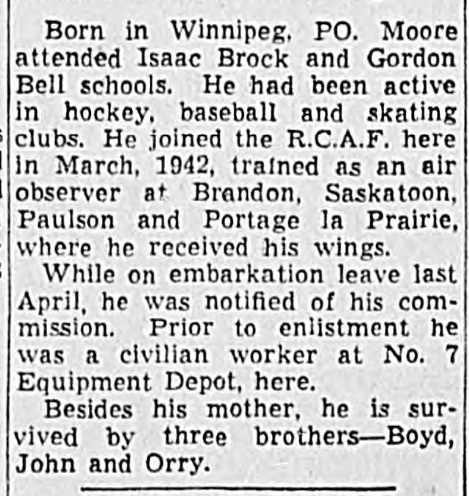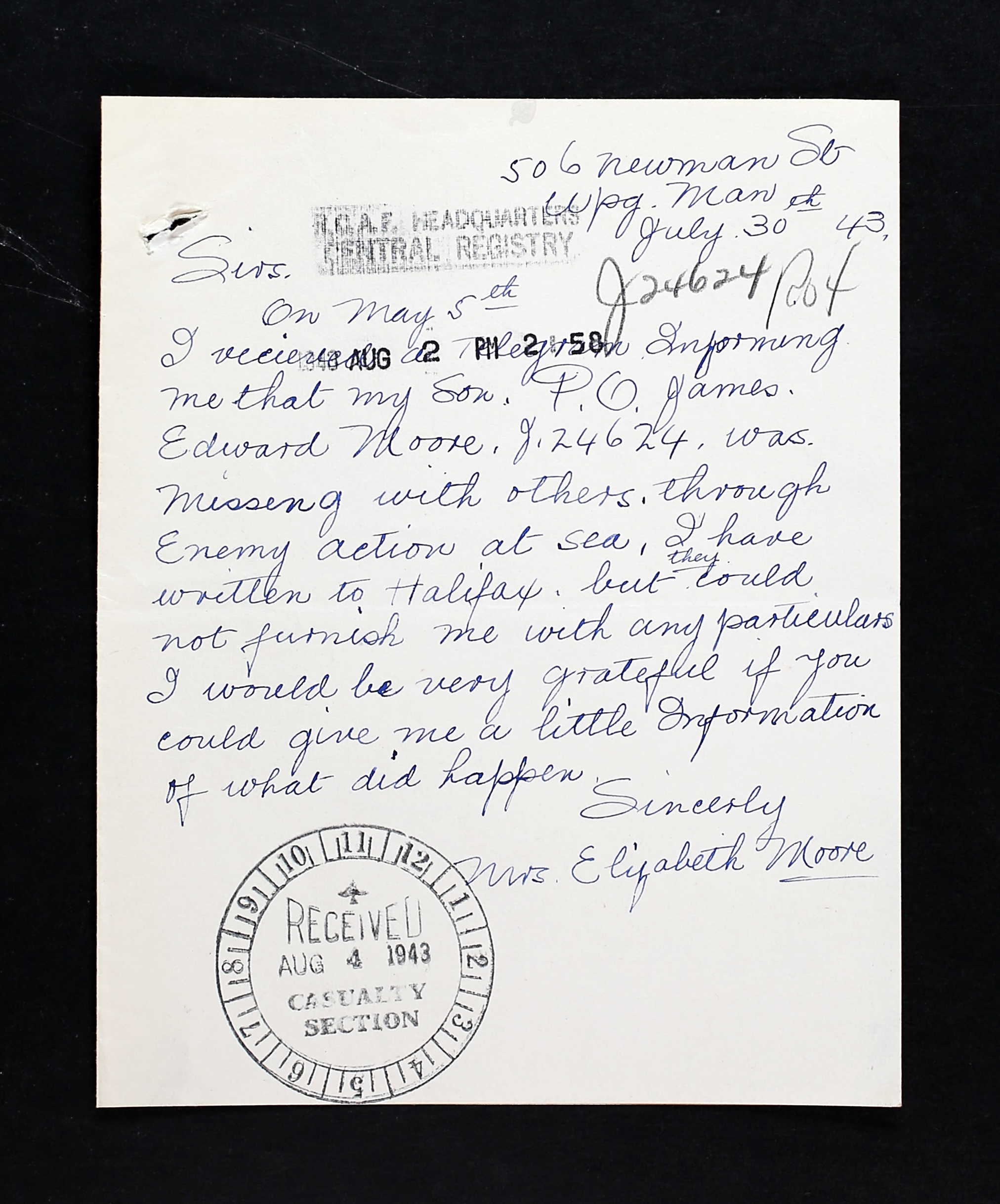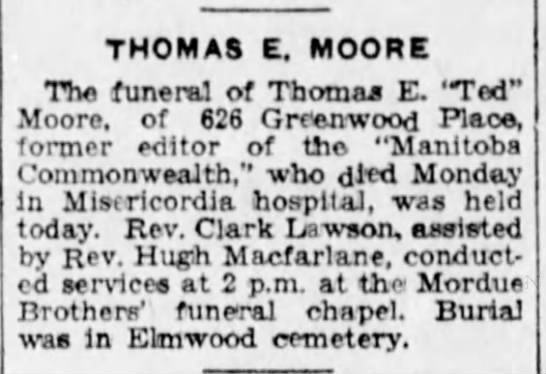



November 4, 1921 - April 22, 1943




James Edward Moore, born in Montreal, Quebec, was the son of Thomas Edward Moore, journalist, and Elizabeth (nee Saxon) Moore of Winnipeg. He had three brothers: Boyd, John, and Orry. Mr. Moore died in the 1935 from cancer. He had been the editor of a periodical, the Manitoba Commonwealth. The family attended the United Church.
In 1927, James had scarlet fever, requiring a tracheotomy, leaving a scar on his neck. He also had had chicken pox as a child.
He had a Grade XI education and had taken a stenographer’s course at Manitoba Commercial College between 1938 and 1939. He was working as a civil servant/Grade 2 clerk for the Dominion Government at No. 7 Equipment Depot, RCAF. He liked to play hockey and rugby. James stood 6’ ¾” tall, weighing 155 pounds. He had hazel eyes, dark brown hair and a fair complexion.
He bought a Victory Loan Bond on March 1, 1942 and paid in installments totaling $7.21. He also took out 2 x $1000 life insurance policies, his mother the beneficiary.
James enlisted in Winnipeg on March 9, 1942. On his interview sheet: “Fit, good type. Clean cut, alert, sincere. Should make excellent aircrew man. Pilot or Observer.” He wanted to pursue engineering after the war. James indicated he had one hour of air time as a passenger. He was assessed as “high average aircrew.” He was seen as “keen and alert, and very anxious to fly. At first examination in August 1941, he was rejected as unfit. Manifest hypermetropia (short sightedness), but claims he read over the glasses.”
He was taken in at No. 2 Manning Depot, Brandon, Manitoba in April until June 1942. From there, he was sent to Brandon for about six weeks until the RCAF found a place for him to start his training.
He was sent to No. 7 ITS, Saskatoon, August 2 and remained there until October 24, 1942. “Pleasant, confident lad with above average ability. Ambitious and straight forward. Bright and alert. Moderately aggressive and good Aircrew material.” He was 36th out of 89 in his class with an 84.1%.
He was then sent to No. 6 SFTS Prince Albert, Saskatchewan until November 15, 1942, when he ceased training. “Progress test revealed this airman’s flying to be below solo standards. He had to be assisted with all landings due, chiefly to tenseness on the controls. Circuit procedure was also below average. This airman is keen to remain in aircrew as Navigator. Progress is satisfactory and he is recommended to be re-selected as an Air Navigator.” On November 25, 1942: “Reason for elimination: Flying Failure. Clean cut, mature, well motivated airman keen to go as A.B. and should handle this job OK.”
James then traveled to Trenton, Ontario to the KTS, Composite Training School, until the RCAF decided what type of training James would continue with.
From December 5, 1942 to February 6, 1943, he was at No. 7 B&G School, Paulson, Manitoba, the sent to No. 7 AOS, Portage la Prairie until February 7, 1943. At Paulson: “Average bombing results. Good in theory. Very good gunner. Steady and reliable. Very good understanding of both guns and theory.” James was 6th out of 29 in his class and received an 80.9%. At Portage la Prairie: “Navigation: Air. Work has progressed throughout the ourse. Logs are neat and accurate and contain all essential information. Good organization. Ground somewhat inconsistent at first but has now a thorough knowledge of all his work. Fair Bomb Aimer. Keen good appearance. Expresses himself well.” He was first in his class of 24 with an 84.8% average.
James received his commission on March 19, 1943, along wit hhis Air Bomber’s Badge.
By April 4, 1943, James was at Y Depot, Halifax, and awaiting transport overseas.
Sometime later, he, with 36 other RCAF airmen, boarded the Amerika. On April 22, while on its way from Halifax, Nova Scotia to Liverpool, it was torpedoed as the ship was heading to Britain. It was a straggler in convoy HX-234. Thirty-seven men, all officers in the RCAF, were presumed missing as a result of enemy action at sea including James. Their ship was sunk by U-306, south of Cape Farewell, off Greenland.
Forty-two crew members and seven gunners were also amongst those who were lost. The master, Christian Nielsen, 29 crewmembers, eight gunners, and sixteen passengers (RCAF airmen) were picked up by the HMS Asphodel, and landed at Greenock. General cargo, including metal, flour, meat and 200 bags of mail were also lost.
Mrs. Moore received a letter dated June 25, 1943 from F/L W. R. Gunn, RCAF Casualties Officer for Chief of the Air Staff. "Since my letter of May 6th, no additional news has been received. Attached is a list of the names and next-of-kin of sixteen Royal Canadian Air Force officers who embarked on the same ship as your son and following enemy action at sea were safely landed in the United Kingdom. The following official statement was made in the House of Commons....’I have been in receipt of communications from a number of members of this house and from people outside with reference to rumours regarding the recent loss of a number of members of the RCAF by the sinking of a ship in the north Atlantic and I desire to make the following statement on the facts. The vessel in question was a ship of British registry of 8,862 tons, designed for peace-time carriage of both passengers and freight, and having a speed of fifteen knots. She carried a crew of 86 and the passenger accommodation consisted of 12 two-berth rooms with bath and 29 other berths, providing cabin accommodations for 53 passengers. She was fitted with lifeboat capacity for 231 and travelled in naval convoy. Under the recently revised regulations agreed to by the United States authorities, the joint United Kingdom and United States shipping board, the Admiralty, the Air Ministry and the Canadian authorities, a vessel of this description travelling in convoy is permitted to embark as crew and passengers a maximum of 75% of the lifeboat capacity. The lifeboat capacity as stated above was 231, 75% of which is 173. Personnel on board consisted of the crew of 86, and RCAF personnel numbering 53, a total of 139, well within the prescribed limits. Because of the superior type of available passenger accommodation, the speed of the ship and the provision of naval convoy, the offer of the entire available space to the RCAF was immediately accepted. Rumours to the effect that this was a slow freighter not suitable for passenger accommodation are, of course, not in accord with the facts. Every precaution was taken to safeguard the lives of these gallant young men. It should be pointed out that on account of the serious shipping shortage every available berth on such ships must be used, and had the space not been taken up by the RCAF officers of the other arms of the services would have been placed on Board. It should also be stated again that the submarine is still the enemy’s most powerful weapon and that the Battle of the Atlantic is not yet won. Any ocean trip today in any part of the world is fraught with danger and I think I may safely say that our record in transporting our soldiers and airmen to the United Kingdom is one of while we may all be proud. No one deplores more than I do the loss of 37 of the finest of our young men who gave their lives for their country as surely as if they had done so in actual combat with the enemy, and I extend my deepest sympathy to their loved ones in their bereavement.’ If further information becomes available, you are to be reassured it will be communicated to you at once. May I again extend to you my sincere sympathy in this time of great anxiety."
Attached to the letter was a list of the names and next-of-kin of sixteen RCAF officers who embarked on the same ship as James, survived, and were safely landed in the UK.
On July 30, 1943, Mrs. Moore wrote to the RCAF. “I have written to Halifax, but they could not furnish me with any particulars. I would be very grateful if you could give me a little information of what did happen.”
In early January 1944, James’s mother received another letter from S/L W. R. Gunn that James would now be presumed dead for official purposes.
Boyd Moore filled out the estates form on behalf of his mother stating that his brother “was on his way overseas at time of his death, as result of enemy action at sea and it is therefore difficult for us to estimate or say whether he had left anything of value on deposit prior to going overseas…he made payments totaling $7.21 on Second Victory Loan Bond prior to enlisting. This is still held by Dept of Finance (Employees Installment Purchase Plan), East Block, Ottawa, Ontario, and efforts to effect a refund have been to no avail. We would appreciate your interest and action in this matter.”
In October 1955, a letter addressed to Mrs. Moore, arrived from W/C W. R. Gunn informing her that James’s name would appear on the Ottawa Memorial, as James had no known grave, expressing sympathy on the loss of her gallant son. It is unknown who received the letter.
Mrs. Moore died in 1962.